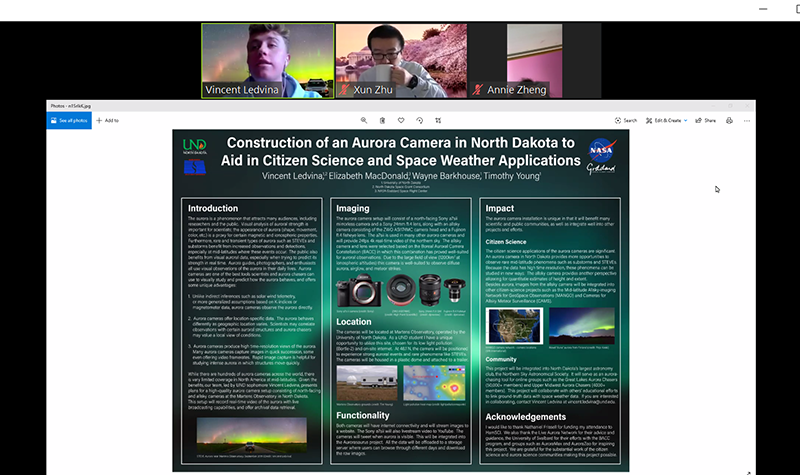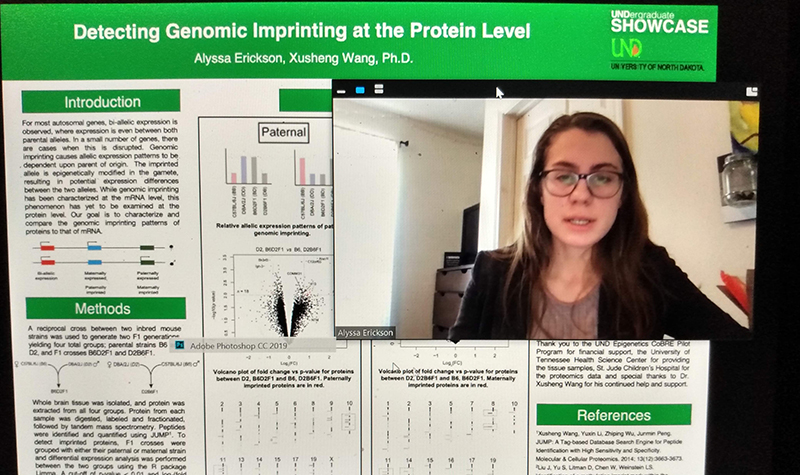UND student researchers take to Zoom to share their work
College of Arts & Sciences’ annual Undergraduate Showcase goes virtual for the first time ever

When a new person entered the Zoom conference, where a dozen attendees had already gathered virtually, Molly Anderson announced she would re-tell her brief talk about her research.
Anderson, a University of North Dakota senior who is graduating this week, had focused her history capstone project (which also served as an Honors thesis) on the contrasting depictions of African soldiers who fought for the French in the First World War. She started delving into the matter a year ago and wrote her final paper this spring.
If it was a normal semester, undisturbed by the coronavirus pandemic, Anderson would have presented her findings in-person during the College of Arts & Sciences Undergraduate Showcase. This year, however, she had to create a digital slide – not a cardboard poster – to summarize her work for online viewing during the remote iteration of the event, held over Zoom last Thursday.
“I will admit, there’s definitely a lot more I wanted to have on the poster,” she said. “But people have to be able to read it on a laptop screen, so there were limitations with that. I think it was good at the same time because it made me a little bit more concise about the information I included.”
During the virtual Undergraduate Showcase, Anderson was among 10 A&S students to hold their private Zoom “rooms,” where, in the course of a little over an hour, anyone could join them to chat about their research.
“Because the Showcase represents a way for students to put their work in front of a public audience, going virtual actually facilitated reaching more people than might have been able to attend an in-person event,” said Ryan Zerr, associate dean of A&S, who pioneered the event about 5 years ago.
Since its inception, the research showcase has grown into a culminating experience for their students producing research or completing capstone assignments. Professors have encourage participation, while students have also embraced the occasion as a way to share their work with a campus-wide audience.
“For these reasons alone we wanted to do everything we could to ensure it could still happen,” despite the remote instruction and work rules UND has enacted amid the pandemic, said Zerr.
For communication senior Chad O’Shea, who also works as an admission representative at UND Admissions, the online event meant a little less preparation – no poster to print out. Putting together his presentation on how media outlets cover female athletes versus their male counterparts, however, he wondered whether the Zoom setup would deliver the personal connection and lively conversation he hoped for.
Starting at 11am, O’Shea’s digital “room” populated with about half a dozen people, including his faculty advisor Soojung Kim, assistant communication professor, and Chuck Haga, a long-time writer for the Star Tribune of Minneapolis and the Grand Forks Herald who now teaches writing part-time at the University. Together, they talked about the role of social media campaigns in shaping the narratives around athletes. They mused about the changes that a post-pandemic reality might spur in sports broadcasting.
“People can drop in and out as if it was a normal event and ask questions,” O’Shea said toward the end of his Zoom session. “I think it’s working out.”

For Alyssa Erickson, who is studying molecular and integrative biology, the virtual event also engendered a new dynamic. Whereas an in-person Showcase would buzz with attendees who might only read her poster without asking any questions, a private Zoom meeting almost mandated an interaction.
And on Thursday morning, Erickson, who is graduating in a year, was ready to engage with those who joined her to learn about genomic imprinting on protein level. To a lay person, the topic sounds complicated – and it is. It deals with gene modifications, occurrences Erickson is exploring in assistant biology professor Xusheng Wang’s lab.
“This is actually a topic I’ve been interested in for a few years now,” Erickson said. “I took a seminar class about epigenetic modifications and disease states about a year ago, and it got me really interested in epigenetics that are passed down from generation to generation.”
About 15 minutes after Erickson’s Zoom session ended, physics sophomore Vincent Ledvina logged into his. Fascinated by Auroras, the intricate displays of lights that occur in Earth’s sky due to solar winds, Ledvina is developing a camera system to capture the phenomenon from the Martens Observatory that UND operates. The project is supported by NASA Goddard Space Flight Center, where Ledvina will intern this summer.

Last year, during a geophysical conference in San Francisco, Ledvina met Liz MacDonald, a space weather scientist at the Center, and struck a working relationship with her.
“We had an idea together for an Aurora camera in North Dakota since North Dakota does actually experience Auroras frequently,” he said. “We thought it’d be a really great location to include a camera, and there’s not a lot of Aurora cameras to begin with in the U.S.”
The project, Ledvina said, blends his two passions – photography and science.
“An Aurora camera is really a neat tool because you don’t need to have a science background to actually be able to use it,” he said. “It’s a really valuable way to communicate something that’s so complex.”
That last sentiment – the idea of a simple way to share tangled notions, to celebrate student researchers who help advance and explain arts and science – could also be applied to the A&S Undergraduate Showcase, which has now proved to transcend modes of communication.


